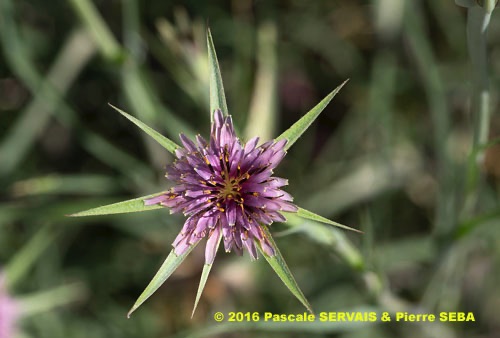
Tragopogon porrifolius subsp. australis (Jord.) Nyman
Fam. : Asteraceae
© Pascale SERVAIS & Pierre SEBA, 2019. Tilo Botanica: Flore de Tilos et du Dodécanèse / Flora of Tilos and of the Dodecanese
English translation by Brenda Bradbury, Howard Bradbury and Stéphane Léonard
Plante herbacée, hermaphrodite, à tiges dressées, glabres, parfois ramifiées, renflées sous les capitules.
Feuilles alternes, simples, linéaires, étroites, à large base engainante.
Fleurs mauves à violet foncé noirâtre, nombreuses, réunies en capitules de 25 à 40 mm de diamètre, entourés d’un involucre de 8 à 12 bractées environ 2 fois plus longues que les fleurons ligulés. En fin de floraison, les bractées se referment puis s’ouvrent à nouveau à la fructification. Ovaire infère.
Fruits, akènes à aigrette plumeuse, disposés en têtes sphériques caractéristiques.
___________________________
Plant herbaceous, hermaphrodite. Stems erect, glabrous, sometimes branched, swollen under the capitula.
Leaves alternate, simple, linear, narrow, with a wide, sheathing base.
Flowers mauve to blackish dark violet, numerous, joined together in capitula from 25 to 40 mm in diameter, surrounded by an involucre from 8 to 12 bracts approximately twice longer than the ray-florets. At the end of the flowering, the bracts close up then open again at fructification. Ovary inferior.
Fruits, achenes with a feathery pappus, laid out in typical spherical heads.
Descripteurs / Identifying features
1
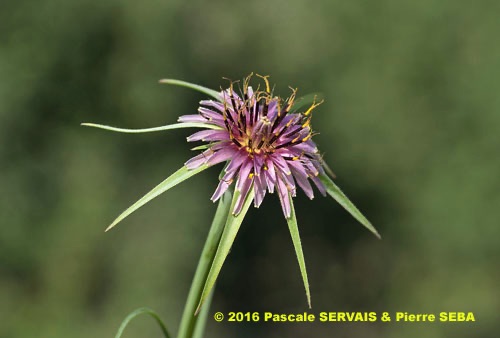
2
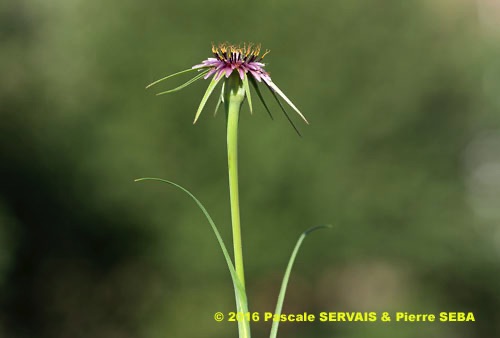
3
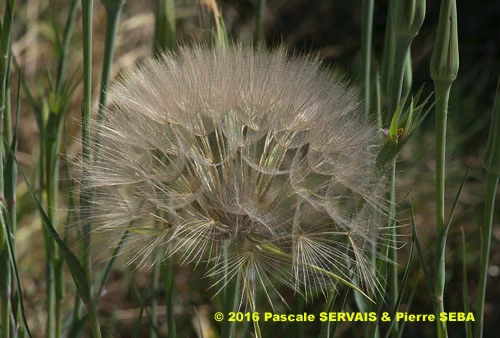
4
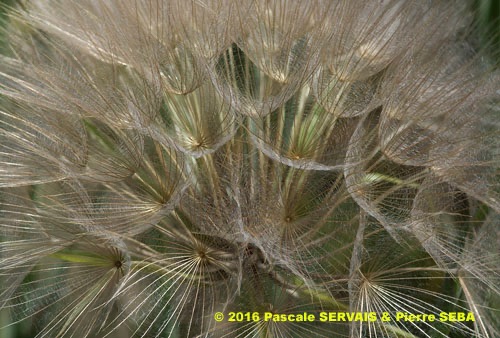
5
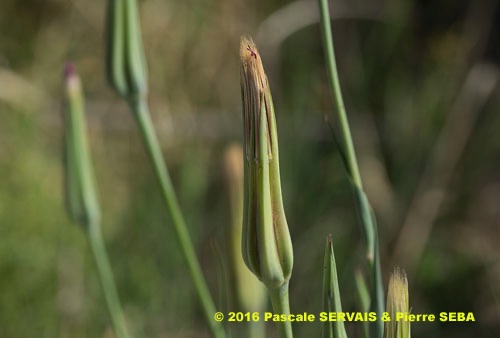
6
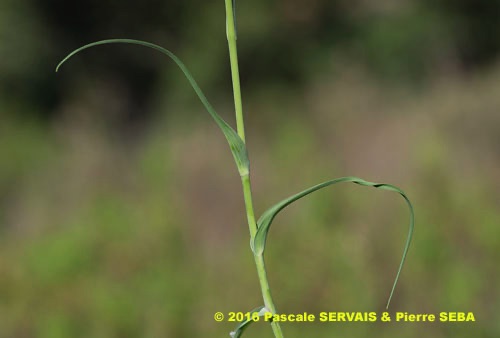
7
Étymologie / Etymology :
Tragopogon : emprunt du latin tragopogon, -onis (adj.) = le salsifis,
nom donné à la plante par Pline, naturaliste latin mort en 79 apr. J.-C.,
forme latinisée du grec ancien τραγοπώγων, -ωνος (nom)
[ < τράγος, -ου (nom) = le bouc + πώγων, -ωνος (nom) = la barbe ]
= la barbe de bouc, le salsifis, nom donné à la plante par Théophraste,
philosophe péripatéticien, disciple d’Aristote, botaniste et naturaliste,
mort vers 288 av. J.-C., en référence aux aigrettes plumeuses des
fruits.
Porrifolius : adjectif créé par les botanistes [ < porrus (porrum), -i (nom)
= le poireau + folium, -i (nom) = la feuille ] = à feuilles de poireau,
qui a des feuilles semblables à celles du poireau.
Australis : emprunt du latin australis, -is, -e (adj.) [ < auster, -tri (nom)
= le vent du sud ] = du sud, méridional.
Tragopogon : borrowed from Latin tragopogon, -onis (adj) = salsify,
name given to the plant by Plinius, Latin naturalist died in 79 AD,
Latinized form of the Classical Greek τραγοπώγων, -ωνος (noun)
[ < τράγος, -ου (noun) = goat + πώγων, -ωνος (noun) = beard ]
= goat's beard, salsify, name given to the plant by Theophrastus,
peripatetic philosopher, disciple of Aristotle, botanist and naturalist,
died towards 288 BC, referring to the feathery pappus of the fruits.
Porrifolius : adjective created by botanists
[ < porrus (porrum), -i (noun) = leek + folium, -i (noun) = leaf ] =
with leek-like leaves, which has leaves similar to those of the leek.
Australis : borrowed from Latin australis, -is, -e (adj)
[ < auster, -tri (noun) = wind from the south ] = which comes from the
south, meridional.
Synonymes / Synonyms :
Tragopogon porrifolius subsp. porrifolius
Tragopogon sinuatus Avé-Lall.
Tragopogon australis Jord.
Tragopogon coelesyriacus Boiss.
Tragopogon longirostris Sch.Bip.
Noms vernaculaires / Common names :
Noms français / French names :
Salsifis austral — Salsifis blanc — Salsifis du Midi.
Noms grecs / Greek names :
Λαγόχορτο — Σκούλος — Τραγόπωγον πρασσόφυλλον —
Τραγόπωγον το πρασόφυλλον — Τραγοπώγονα — Τραγοπώγων —
Τραγοπώγων ο πρασόφυλλος.
Noms anglais / English names :
Salsify — Southern salsify — Vegetable oyster.
Noms allemands / German names :
Haferwurzel — Roter Bocksbart — Südlicher Roter Bocksbart.
Noms espagnols / Spanish names :
Barba cabruna — Salsifí blanco.
Nom italien / Italian name :
Barba di becco violetta.
Habitat :
Cultures - Prairies - Lieux incultes - Chemins.
Cultivated places - Meadows - Waste ground - Waysides.
Îles / Islands :
Patmos - Rhodos - Tilos.
Hauteur / Height range :
De 20 cm à 70 cm.
From 20 cm to 70 cm.
Floraison / Flowering time :
De février à juin.
From February to June.
Groupe / Classification :
Dicotylédones.
Dicotyledons.
Pérennité / Lifespan :
Bisannuelle.
Biennial.
Description :
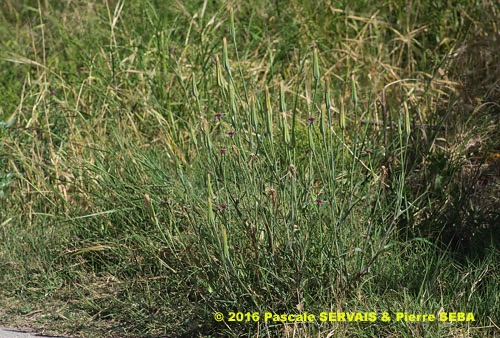
8
Clés dichotomiques et descripteurs distinctifs des 3 espèces / Dichotomous keys and distinctive identifying features of the 3 species
Photo 1 :
Localisation / Location : Tilos, Livadia, Village
Date : 16/04/2016
GPS : Lat. 36,41207° N / Long. 27,38769° E / Alt. 4 m
Type : Photographie numérique / Digital Photograph (24 mégapixels)
Photo 2 :
Localisation / Location : Tilos, Livadia, Village
Date : 16/04/2016
GPS : Lat. 36,41207° N / Long. 27,38769° E / Alt. 4 m
Type : Photographie numérique / Digital Photograph (24 mégapixels)
Photo 3 :
Localisation / Location : Tilos, Livadia, Village
Date : 16/04/2016
GPS : Lat. 36,41207° N / Long. 27,38769° E / Alt. 4 m
Type : Photographie numérique / Digital Photograph (24 mégapixels)
Photo 4 :
Localisation / Location : Tilos, Livadia, Village
Date : 14/04/2016
GPS : Lat. 36,41207° N / Long. 27,38769° E / Alt. 4 m
Type : Photographie numérique / Digital Photograph (24 mégapixels)
Photo 5 :
Localisation / Location : Tilos, Livadia, Village
Date : 14/04/2016
GPS : Lat. 36,41207° N / Long. 27,38769° E / Alt. 4 m
Type : Photographie numérique / Digital Photograph (24 mégapixels)
Photo 6 :
Localisation / Location : Tilos, Livadia, Village
Date : 16/04/2016
GPS : Lat. 36,41207° N / Long. 27,38769° E / Alt. 4 m
Type : Photographie numérique / Digital Photograph (24 mégapixels)
Photo 7 :
Localisation / Location : Tilos, Livadia, Village
Date : 16/04/2016
GPS : Lat. 36,41207° N / Long. 27,38769° E / Alt. 4 m
Type : Photographie numérique / Digital Photograph (24 mégapixels)
Photo 8 :
Localisation / Location : Tilos, Livadia, Village
Date : 16/04/2016
GPS : Lat. 36,41207° N / Long. 27,38769° E / Alt. 4 m
Type : Photographie numérique / Digital Photograph (24 mégapixels)

Google Maps
Google Maps
Google Maps
Google Maps
Google Maps
Google Maps
Google Maps
Google Maps